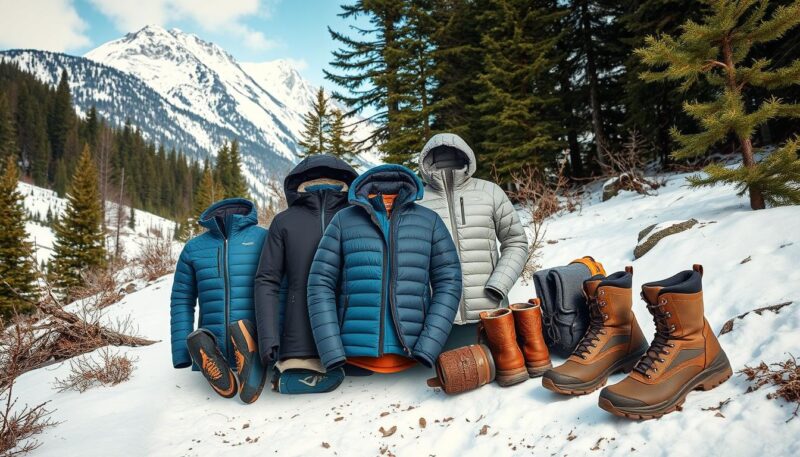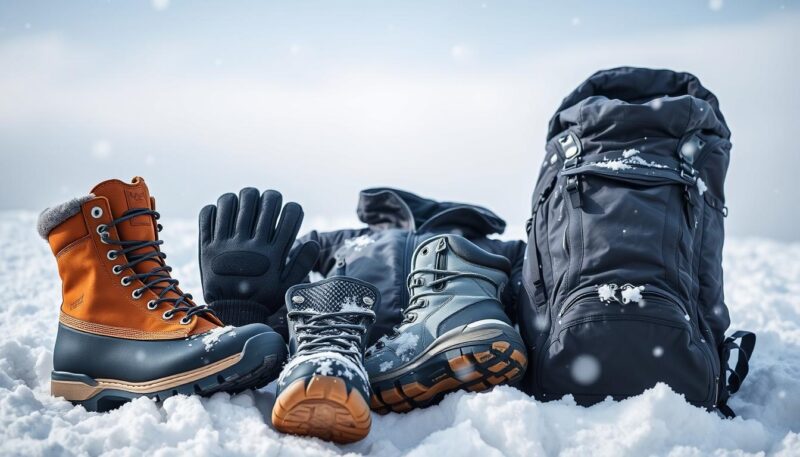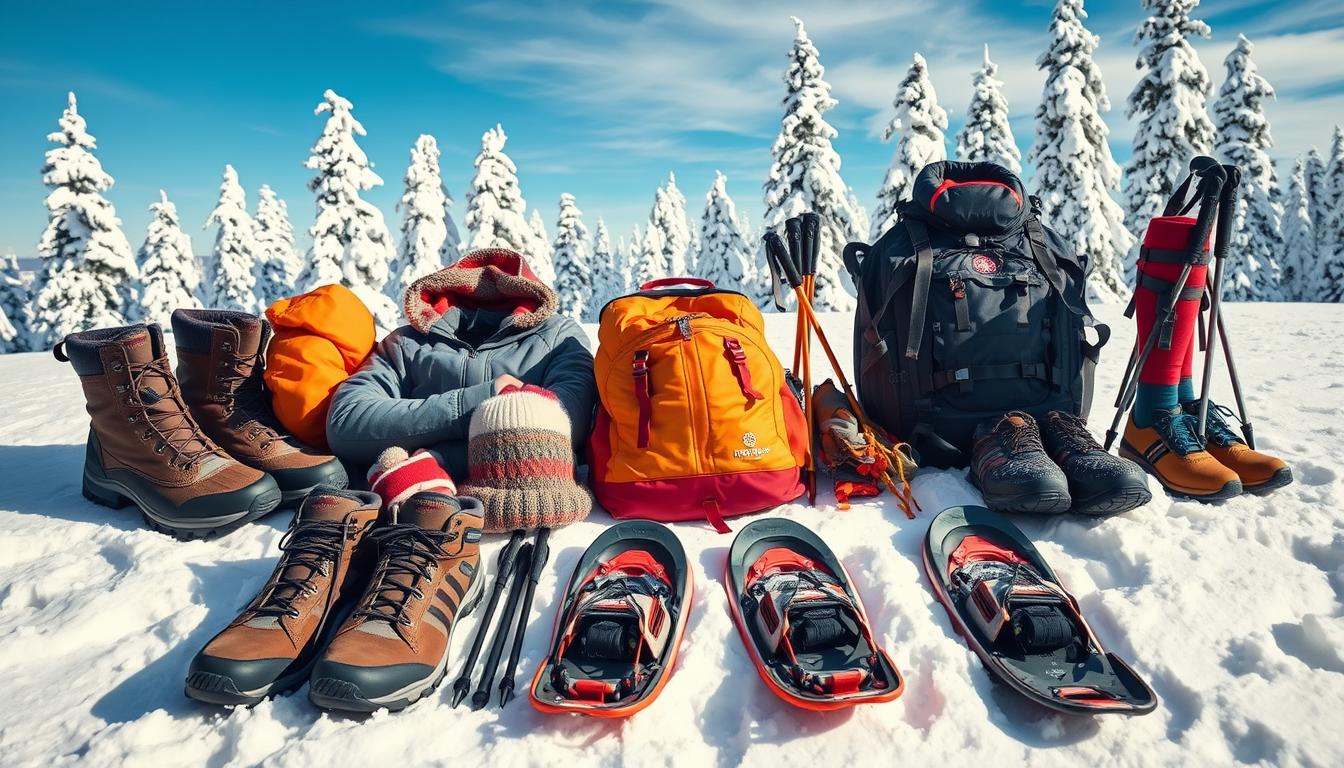When winter rolls around, hiking enthusiasts may find themselves uncertain about venturing into the snowy wilderness. However, with the right winter hiking gear essentials, including thermal pants, a waterproof jacket, and strategic layering for cold-weather hiking, you can enjoy the beauty of winter trails safely and comfortably. Understanding the importance of proper gear selection is crucial to staying warm, dry, and safe.
A story that resonates with many hikers is the experience of allowing boots to get wet and freeze overnight. This common mistake serves as a reminder of why appropriate footwear and accessories are vital. High-quality insulated boots, versatile layering options—from moisture-wicking base layers to insulating mid-layers, and weatherproof outer layers—and essential cold-weather accessories play a significant role in navigating snowy terrains with ease.
Brands like Smartwool, with its Merino layers, and Patagonia, known for its fleece and shell jackets, offer products designed to enhance comfort and safety in harsh winter conditions. It’s not just about the brands, however; the underlying principle is to manage perspiration and body temperature effectively through strategic layering. Your layers will often need to be adjusted based on your activity level and hiking companions, ensuring that you remain comfortable and safe throughout your adventure.
Key Takeaways
- Invest in quality winter hiking gear essentials, including thermal pants and a waterproof jacket.
- Focus on managing perspiration and body temperature through effective layering.
- Brands like Smartwool and Patagonia provide reliable products for winter hikes.
- Avoid common mistakes like letting your boots get wet and freeze overnight.
- Stay warm, dry, and safe by choosing the right footwear and accessories.
- Adjust your layers based on your activity level and the conditions.
Essential Winter Hiking Footwear
Winter hiking presents unique challenges that require proper footwear to ensure warmth and safety. Essential winter hiking footwear addresses two vital conditions: warmth and traction. Let’s delve into the specifics of what you need for a successful winter hike, encompassing insulated boots, grip-friendly boots, and the perfect choice of socks.
Insulated Boots for Warmth
Warmth is a top priority when selecting winter hiking boots. Boots such as those from brands like Columbia and The North Face are recommended for their ability to maintain heat even in extreme conditions. These warm insulated footwear options often feature waterproof materials, ensuring that your feet stay dry while traversing snowy landscapes. Depending on your hiking destination, you may need boots rated for temperatures as low as 20 to 40 degrees below zero for advanced mountaineering.
Grip-Friendly Boots for Traction
Safety on icy and snowy trails is paramount. Grip-friendly boots equipped with specialized tread patterns are essential for preventing slips and falls. Brands like Merrell and Salomon design these boots with advanced traction devices for snowy hikes, ensuring stable and secure footing. These boots typically feature rubber soles optimized for icy conditions, providing the necessary grip to tackle challenging terrains.
Proper Sock Selection
Choosing the right socks is crucial to complement your winter hiking boots. Wool socks, particularly those made from Merino wool, offer excellent warmth and moisture-wicking properties. Unlike cotton socks, which can retain moisture and lead to discomfort or hypothermia, wool socks keep your feet dry and warm. The insulation provided by these socks reduces the risk of blisters, making them a perfect choice for long winter hikes.
| Feature | Recommended Brands | Details |
|---|---|---|
| Insulated Boots | Columbia, The North Face | Waterproof, warm insulated footwear for extreme temperatures |
| Grip-Friendly Boots | Merrell, Salomon | Specialized tread patterns, essential traction devices for snowy hikes |
| Socks | Smartwool, Darn Tough | Merino wool socks for warmth, moisture-wicking properties |
Layering: The Key to Comfort
The art of layering for winter hiking is a crucial skill that ensures optimal body temperature regulation and safety. Whether you are traversing snowy trails or facing brisk winds, understanding how to layer effectively can make or break your outdoor experience.

Base Layers for Moisture Wicking
Start with a base layer designed to wick moisture away from your skin. Materials such as lightweight merino wool and polyester are popular choices. Merino wool, like the Merino Tech Tee by Voormi, boasts a high warmth-to-weight ratio and is ideal for maintaining warmth without bulk. On the other hand, synthetic base layers, such as the All Day Tee by Territory Run Co, are typically more durable and stretchy, offering excellent moisture-wicking properties. Always carry an extra base layer for emergencies.
Mid Layers for Insulation
The mid-layer is your primary source of insulation. Fleece jackets and synthetic insulating jackets are exceptional choices for this layer. Items like the Enlightened Equipment Torrid APEX provide lightweight synthetic insulation, while the Mountain Hardwear Ghost Whisperer Jacket is a favored down jacket among thru-hikers. Your mid-layer should be easily adjustable to adapt to varying levels of activity and weather conditions.
Outer Layers for Weather Protection
Finally, the outer layer protects against wind and precipitation. Waterproof hardshell jackets are essential for staying dry and blocking the wind. The Enlightened Equipment Visp Rain Jacket is suitable for lighter activities, while the Arc’teryx Beta AR Jacket offers heavier protection for extremely wet days. As for the bottom half, Zpacks Vertice Rain Pants are recommended for cold and wet conditions. Personal experience and preferences will dictate the specific products and materials you choose, but the aim is always to maintain warmth without becoming damp from sweat.
Crucial Cold-Weather Accessories
When it comes to winter hiking gear, the importance of cold-weather hiking accessories cannot be overstated. Your extremities and face are particularly vulnerable to the cold and must be adequately protected to ensure a safe and enjoyable hike. Among the most essential items in your winter hiking gear arsenal are thermal gloves, insulating beanies, and neck gaiters.

Thermal gloves are indispensable for keeping your hands warm and dry, while insulating beanies protect your head, a critical area for heat retention. Neck gaiters not only provide an additional layer of warmth but also shield your face from biting winds and blowing snow. These cold-weather hiking accessories are designed to maintain your comfort and safety, reducing the risk of hypothermia and frostbite.
To maximize the effectiveness of your winter hiking gear, choose high-quality materials that wick away moisture and provide adequate insulation. Your selection of cold-weather hiking accessories can make a significant difference, turning a potentially hazardous winter hike into a memorable adventure. Preparing thoughtfully and choosing the right accessories ensures you stay warm, dry, and protected in all conditions.
Winter Hiking Gear Checklist
Embarking on a winter hiking adventure requires thorough preparation. A comprehensive winter hiking checklist ensures safety and comfort, allowing you to fully enjoy the breathtaking winter landscapes. Below, you’ll find the essential hiking gear you’ll need, listed under crucial categories.
Backpack Essentials
When compiling your winter hiking checklist, remember that your backpack should be large enough to accommodate all necessities, ideally between 35-60 liters. A well-packed backpack will help you navigate changing weather conditions and unexpected situations. Consider including the following:
- Insulated water bottle carriers (or a wool sock to put over each bottle) to prevent freezing.
- Emergency shelters like SOL emergency bivvies for unforeseen overnight stays.
- A navigation system such as a map and compass, considering that cell phones rarely have reception in remote areas.
- An extra set of liner gloves and socks for warmth and comfort.
- Cold-weather protection, including extra layers and a winter sleeping bag rated around 20 degrees Fahrenheit.
- A repair kit including sewing items, paracord, duct tape, and zip ties for on-the-go fixes.
- Waterproof gaiters to keep snow out of your boots.
- A power bank, with the Nitecore power bank being a popular choice, to keep devices charged as cold temperatures can rapidly drain battery life.
Traction Devices
Ensuring proper traction is crucial for safe winter hiking. Depending on trail conditions, you might need microspikes or crampons to maintain stability on icy terrain. Here are some key points to consider:
- Choose microspikes for less challenging trails with packed snow and light ice.
- Opt for crampons when facing steep, icy, or technical terrain.
- Always carry trekking poles with winter baskets to assist with balance and stability on uneven surfaces.
- For regions like the High Peaks Wilderness, carrying snowshoes is required by state law when there is 8 inches or more of off-trail snow.
Having the right traction devices and backpack essentials in your winter hiking checklist can make all the difference in ensuring a safe and enjoyable outdoor experience. Prioritize safety by thoroughly preparing and equipping yourself with this essential hiking gear for your next winter adventure.
Conclusion
Concluding our discussion on winter hiking gear, it becomes evident that the pathway to safe winter hiking hinges on thorough preparedness and the cultivation of cold-weather hiking expertise. The choices you make in selecting the right gear play a pivotal role in your ability to navigate the rigors of winter landscapes, ensuring both safety and enjoyment.
Embracing a systematic approach to layering, you can efficiently manage body temperature and moisture. A proven three-layer system includes a moisture-wicking base layer, an insulating mid-layer, and a weather-proof outer shell. Additionally, essential accessories such as insulated waterproof boots, thermal underwear, gloves, mittens, and headgear are critical in maintaining comfort and protection against the cold.
Here is a comparative breakdown of essential gear weights for different seasons, highlighting the necessity of understanding the specific demands of winter versus summer hiking.
| Item | Winter Setup | Summer Setup |
|---|---|---|
| Shelter | Big Agnes Cooper Spur HV UL 2 – 3lbs. 2oz | Six Moons Skyscape Trekker Tent – 28oz / Zpacks Duplex – 19oz |
| Pack | Six Moons Swift X – 37oz | — |
| Pad | Thermarest XTherm – 19.5oz | Sea to Summit Women’s Comfort Light Insulated Air – 1lb. 5oz |
| Quilt/Sleeping Bag | Enlightened Equipment Revelation Quilt – 22.9oz | Sea To Summit Women’s Flame Ultralight Down Sleeping Bag – 12.3oz |
| Liner | Sea to Summit Reactor Extreme Liner – 14oz | Sea to Summit Reactor Thermolite Liner – 8.7oz |
| Booties | Goosefeet Gear Down Socks – 2oz per pair | — |
| Hood | Goosefeet Gear Down Balaclava (Double-Filled) – 2.4oz | — |
By leveraging these detailed insights and statistical comparisons, you can confidently prepare for your winter adventures. Recognizing the nuances of winter hiking, such as the critical weight-to-warmth ratio and the importance of breathable fabrics, provides a solid foundation for enhancing your cold-weather hiking expertise.
Additional Insights and Winter Hiking Resources
Venturing into the realm of winter hiking extends beyond choosing the right gear. Delve deeper by exploring expert tips on winter hiking preparation, safety courses, and the art of thermal regulation. Valuable resources such as detailed gear reviews and survival tips can elevate your understanding and proficiency, making every hike not only enjoyable but also safer.
It’s essential to stay informed about how to regulate your body temperature, prevent perspiration-related cooling, and recognize early signs of frostbite and hypothermia. Implementing a strategic layering system is crucial; start with a moisture-wicking base layer made from synthetic fabric or merino wool, add an insulation layer such as down or fleece, and top it off with a waterproof breathable outer shell. Brands like Icebreaker, Patagonia, Outdoor Research, and REI Co-op are recommended for high-quality, long-lasting gear. Remember that different trail difficulties and weather conditions dictate various layering needs, so ensure your layers are easily accessible and avoid cotton due to its dampness when wet.
Beyond gear, learning from experienced winter hikers can provide insights and practical advice. Engage with community forums, participate in local workshops, or even consider courses on winter survival and avalanche training for a more comprehensive understanding. Embracing these resources and personal recommendations will round out your winter hiking preparation journey.
Preparedness is key to a rewarding winter hiking experience. Equip yourself with a complete checklist of essentials, including traction devices, calorically dense foods, hot beverages, navigation tools, and emergency gear, to ensure you are ready for whatever nature throws your way. By investing time in research, recognizing the risks, and making informed choices, you can transform each winter hike into a safe and exhilarating adventure.
FAQ
What are the essential items for a winter hiking gear checklist?
Essential items for a winter hiking gear checklist include layered clothing (base layers, mid-layers, and outer layers), insulated boots, traction devices (such as microspikes or crampons), gloves, beanies, neck gaiters, trekking poles with winter baskets, a reliable navigation system, and extra food and water.
How do I choose the right insulated boots for warmth?
Choosing the right insulated boots involves looking for features such as waterproofing, insulation ratings, and proper fit. Brands specializing in winter hiking boots often feature technologies that ensure warmth without compromising flexibility. Consider boots specifically designed for low temperatures and make sure they are compatible with traction devices.
Why is layering important for cold-weather hiking?
Layering is crucial for cold-weather hiking as it allows you to regulate your body temperature by adding or removing layers based on your activity level and weather conditions. This system helps manage perspiration and maintain warmth, making your hike more comfortable and safe.
What type of base layers should I use for moisture-wicking?
Base layers made from materials like lightweight wool or polyester are excellent for moisture-wicking. These fabrics keep your skin dry, which is essential for maintaining warmth. Smartwool’s Merino layers are a popular choice for their effective moisture management and thermal properties.
What are good mid-layer options for insulation?
Good mid-layer options include fleece jackets and synthetic insulating jackets. Patagonia’s fleece and shell jackets are examples that offer adjustable warmth while being lightweight and breathable. These layers trap body heat and can be easily modified to suit changing conditions during the hike.
How can I protect my extremities from the cold during winter hikes?
Protect your extremities by wearing thermal gloves, insulating beanies, and neck gaiters. These cold-weather accessories help retain warmth and shield you from wind and snow. High-quality options, such as those provided by brands known for outdoor gear, ensure added comfort and safety.
What should I look for in grip-friendly boots for traction?
Look for grip-friendly boots with specialized tread patterns and materials that enhance traction on icy terrain. Brands like Merrell and Salomon offer boots designed for winter conditions, providing stable and secure footing.
Why is proper sock selection important for winter hiking?
Proper sock selection is important because socks made from materials like Merino wool offer warmth, moisture-wicking properties, and a comfortable fit. These reduce the risk of blisters and help keep your feet dry and warm during long hikes.
What cold-weather accessories are essential for a winter hike?
Essential cold-weather accessories include thermal gloves, beanies, neck gaiters, buffs, and sunglasses. These items protect your extremities and face from the cold, wind, and sun, ensuring a more comfortable and safe experience.
What are some key backpack essentials for winter hiking?
Key backpack essentials for winter hiking include additional layers, a reliable navigation system, extra food and water, traction devices like microspikes or crampons, and trekking poles with winter baskets. Don’t forget the ten essentials for outdoor survival, with an emphasis on items catering to winter-specific hazards.
Source Links
- https://www.treelinereview.com/gear-list/what-to-wear-hiking-in-winter
- https://www.thewanderingqueen.com/winter-hiking-gear-and-clothes/
- https://www.freshoffthegrid.com/winter-hiking-gear/
- https://www.outdoors.org/resources/amc-outdoors/outdoor-resources/winter-hiking-essential-gear-list/
- https://www.erinexploring.com/blog/winter-hiking-clothes-and-gear-guide
- https://www.garagegrowngear.com/blogs/trail-talk/winter-clothing-layering-cold-hiking?srsltid=AfmBOoroSs0J5DWzwGA2V9mwiCyiLH2pH2udYkKc4HS8e6tNlRHaKjVc
- https://sectionhiker.com/how-to-layer-for-winter-hiking/
- https://www.the-hungry-hiker.com/2022/12/11/winter-hiking-what-hiking-gear-to-bring-and-what-to-wear/
- https://www.heatholders.com/blogs/wow/essential-clothing-for-cold-weather-hiking-what-you-need-for-a-safe-and-enjoyable-outing?srsltid=AfmBOopk3NkMXlXr0p534onnY7fswN6ipBJBtt39z6dOLRNQVEr6AyeL
- https://www.garagegrowngear.com/blogs/trail-talk/winter-hiking-gear-checklist?srsltid=AfmBOorZF414x30Nw_uE_SujQPyS0yE9KKprO3b3onunIa72tSM4YGQA
- https://adk.org/winter-day-hiking-gear-list/
- https://www.garagegrowngear.com/blogs/trail-talk/winter-hiking-gear-checklist?srsltid=AfmBOoqVB8J0wXxgKdaJ30ZKaZVW4cahU3swZ7Zq8VjOIClvV09FxG7Q
- https://www.garagegrowngear.com/blogs/trail-talk/winter-vs-summer-thru-hiking-kits-gear?srsltid=AfmBOoqgDt6EExDtkmJMDBsTrPbTry1azm-8Iv3JeI6eoVz7nwCWmoL_
- https://www.ventureheat.com/blogs/articles/essential-winter-hiking-gear?srsltid=AfmBOopYR3pP0PuRHTvVS2tI7Uvz_DRQyw0kHFp92w0Uq9qGz3BWmSQW
- https://backpackinglight.com/forums/topic/37392/
- https://bearfoottheory.com/cold-weather-hiking-clothes-winter-layering-basics/
- https://mountain-hiking.com/winter-hiking-essentials/
- https://missrover.com/winter-hiking-guide-avoiding-avalanches-and-other-important-things/

